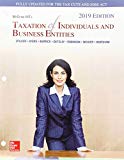
GEN COMBO LL MCGRAW-HILLS TAXATION INDIVIDUALS & BUSINESS ENTITIES; CONNECT AC
10th Edition
ISBN: 9781260259971
Author: Brian C. Spilker Professor
Publisher: McGraw-Hill Education
expand_more
expand_more
format_list_bulleted
Question
Chapter 3, Problem 63P
To determine
Fill the two annual after-tax
Expert Solution & Answer
Want to see the full answer?
Check out a sample textbook solution
Students have asked these similar questions
Financial accounting
Want answer
Hello tutor please provide this question solution general accounting
Chapter 3 Solutions
GEN COMBO LL MCGRAW-HILLS TAXATION INDIVIDUALS & BUSINESS ENTITIES; CONNECT AC
Ch. 3 - 1. The goal of tax planning is to minimize taxes....Ch. 3 - Prob. 2DQCh. 3 - In this chapter we discussed three basic tax...Ch. 3 - What are the two basic timing strategies? What is...Ch. 3 - Prob. 5DQCh. 3 - What are some common examples of the timing...Ch. 3 - What factors increase the benefits of accelerating...Ch. 3 - How do changing tax rates affect the timing...Ch. 3 - Prob. 9DQCh. 3 - Prob. 10DQ
Ch. 3 - Prob. 11DQCh. 3 - What two factors increase the difference between...Ch. 3 - What factors have to be present for income...Ch. 3 - Prob. 14DQCh. 3 - Prob. 15DQCh. 3 - Prob. 16DQCh. 3 - Prob. 17DQCh. 3 - Prob. 18DQCh. 3 - Prob. 19DQCh. 3 - Explain how implicit taxes may limit the benefits...Ch. 3 - Prob. 21DQCh. 3 - Do after-tax rates of return for investments in...Ch. 3 - Prob. 23DQCh. 3 - Prob. 24DQCh. 3 - Prob. 25DQCh. 3 - What is an implicit tax and how does it affect a...Ch. 3 - Several judicial doctrines limit basic tax...Ch. 3 - What is the constructive receipt doctrine? What...Ch. 3 - Prob. 29DQCh. 3 - Relative to arms length transactions, why do...Ch. 3 - Prob. 31DQCh. 3 - Prob. 32DQCh. 3 - Prob. 33DQCh. 3 - Prob. 34DQCh. 3 - Yong recently paid his accountant 10,000 for...Ch. 3 - Billups, a physician and cash-method taxpayer, is...Ch. 3 - Prob. 37PCh. 3 - Prob. 38PCh. 3 - Prob. 39PCh. 3 - Prob. 40PCh. 3 - Prob. 41PCh. 3 - Prob. 42PCh. 3 - Prob. 43PCh. 3 - Prob. 44PCh. 3 - Prob. 45PCh. 3 - Prob. 46PCh. 3 - Prob. 47PCh. 3 - Prob. 48PCh. 3 - Prob. 49PCh. 3 - Prob. 50PCh. 3 - Prob. 51PCh. 3 - Prob. 52PCh. 3 - Prob. 53PCh. 3 - Prob. 54PCh. 3 - Prob. 55PCh. 3 - Prob. 56PCh. 3 - Prob. 57PCh. 3 - Prob. 58PCh. 3 - Prob. 59PCh. 3 - Prob. 60PCh. 3 - Prob. 61PCh. 3 - Prob. 62PCh. 3 - Prob. 63PCh. 3 - Prob. 64PCh. 3 - Prob. 65P
Knowledge Booster
Similar questions
- Apsara Beverages Co. uses process costing to account for the production of bottled sports drinks. Direct materials are added at the beginning of the process, and conversion costs are incurred uniformly throughout the process. Equivalent units have been calculated to be 21,600 units for materials and 18,000 units for conversion costs. Beginning inventory consisted of $13,500 in materials and $7,200 in conversion costs. May costs were $62,400 for materials and $72,000 for conversion costs. The ending inventory still in process was 7,000 units (100% complete for materials, 50% for conversion). The cost per equivalent unit for materials using the weighted-average method would be____.helparrow_forwardTidewell Corporation charges manufacturing overheadarrow_forwardHow much profit does the companyarrow_forward
arrow_back_ios
SEE MORE QUESTIONS
arrow_forward_ios
Recommended textbooks for you





